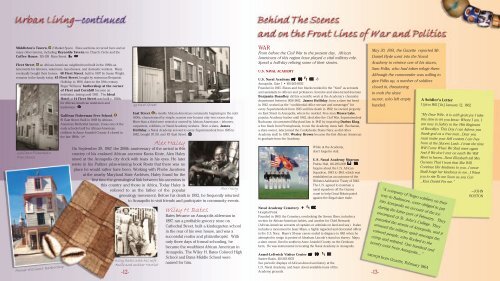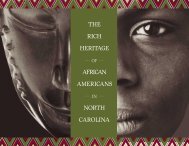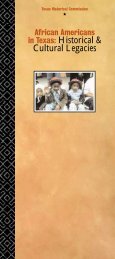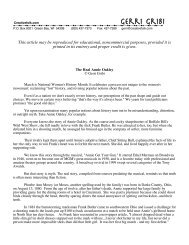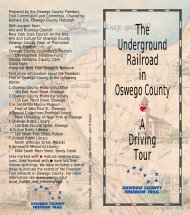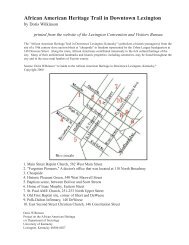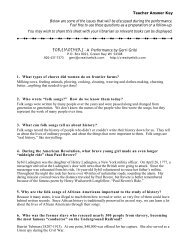Inside this brochure you'll find...
Inside this brochure you'll find...
Inside this brochure you'll find...
You also want an ePaper? Increase the reach of your titles
YUMPU automatically turns print PDFs into web optimized ePapers that Google loves.
Middleton’s Tavern, 2 Market Space. Slave auctions occurred here and at<br />
many other taverns, including Reynolds Tavern on Church Circle and the<br />
Coffee House, 195-199 Main Street.<br />
Fleet Street, 23 an African-American neighborhood built in the 1880s as<br />
tenements for laborers, watermen, laundresses, and domestic workers. Many<br />
eventually bought their homes. 48 Fleet Street, built in 1897 by Susan Wright,<br />
remains in the family today. 45 Fleet Street, bought by waterman Benjamin<br />
Holliday in 1880, dates to the 18th century.<br />
Roger Williams’ barbershop at the corner<br />
of Fleet and Cornhill became an<br />
institution, lasting until 1983. The Ideal<br />
Hotel at 14 Fleet Street was built c. 1920s<br />
for African-American watermen and<br />
tradesmen.<br />
Galilean Fisherman<br />
Free School<br />
Former Williams' Barbershop<br />
22 WAR<br />
Galilean Fisherman Free School,<br />
91 East Street. Built in 1868 by African-<br />
American Methodist laymen, it was one of the<br />
early schools built for African-American<br />
children in Anne Arundel County. It closed in<br />
the late 1890s.<br />
24<br />
99 East Street<br />
East Street, 25 a mostly African-American community beginning in the mid-<br />
1800s, characterized by simple, narrow row houses only two rooms deep.<br />
More than a third were rented or owned by African Americans – laborers,<br />
carpenters, cobblers, or Naval Academy workers. Born a slave, James<br />
Holliday, a Naval Academy servant to every Superintendent from 1845 to<br />
1882, bought 97, 99, and 101 East Street.<br />
Alex Haley<br />
On September 29, 1967, the 200th anniversary of the arrival in <strong>this</strong><br />
country of his enslaved African ancestor Kunta Kinte, Alex Haley<br />
stood at the Annapolis city dock with tears in his eyes. He later<br />
wrote in his Pulitzer prize-winning book Roots that there was no<br />
place he would rather have been. Working with Phebe Jacobsen<br />
at the nearby Maryland State Archives, Haley found for the<br />
first time the genealogical link between his ancestors in<br />
<strong>this</strong> country and those in Africa. Today Haley is<br />
referred to as the father of the popular<br />
Wiley Bates with his wife<br />
Annie and mother Harriet<br />
-12-<br />
Alex Haley<br />
genealogy movement. Before his death in 1992, he frequently returned<br />
to Annapolis to visit friends and participate in community events.<br />
Wiley H. Bates<br />
Bates became an Annapolis alderman in<br />
1897, ran a profitable grocery store on<br />
Cathedral Street, built a kindergarten school<br />
in the rear of his own house, and was a<br />
successful realtor and philanthropist. With<br />
only three days of formal schooling, he<br />
became the wealthiest African American in<br />
Annapolis. The Wiley H. Bates Colored High<br />
School and Bates Middle School were<br />
named for him.<br />
From before the Civil War to the present day, African<br />
Americans of <strong>this</strong> region have played a vital military role.<br />
Spend a half-day reliving some of their stories.<br />
U.S. NAVAL ACADEMY<br />
U.S. Naval Academy<br />
Annapolis, Gate 1 • 410-263-6933<br />
Founded in 1845. Slaves and free blacks worked in the “Yard” as servants<br />
and assistants to officers and professors. Inventor and slave-turned-freeman<br />
Benjamin Boardley did his scientific work at the Academy’s chemistry<br />
department between 1856-1862. James Holliday, born a slave but freed<br />
in 1842, worked as the “confidential office servant and messenger” for<br />
every Superintendent from 1845 until his death in 1882; he owned property<br />
on East Street in Annapolis, where he resided. Free man Moses Lake,<br />
popular Academy barber until 1862, died after the Civil War. Superintendent<br />
Buchanan circumvented Maryland law in 1845 by importing Darius King,<br />
a free black from Pennsylvania, to run the Academy mess hall. Buchanan,<br />
a slave owner, later joined the Confederate States Navy, as did other<br />
Academy staff. In 1949, Wesley Brown became the first African American<br />
to graduate from the Academy.<br />
While at the Academy,<br />
don’t forget to visit:<br />
U.S. Naval Academy Museum<br />
Preble Hall, 410-293-2109<br />
Inquire about the U.S. African<br />
Squadron, 1843 to 1861, which was<br />
established as an outcome of the<br />
Webster-Ashburton Treaty of 1842.<br />
The U.S. agreed to maintain a<br />
naval squadron off the Guinea<br />
coast to help Great Britain patrol<br />
against the illegal slave trade.<br />
Naval Academy Cemetery<br />
Hospital Point<br />
Founded in 1869, the Cemetery, overlooking the Severn River, includes a<br />
section for African-American babies, and another for Chief Stewards<br />
(African-American servants of captains or admirals on land and sea). It also<br />
includes a monument to Isaac Mayo, a highly regarded and decorated officer<br />
in the U.S. Navy. Mayo’s 53-year career ended in disgrace in 1861 when he<br />
attempted to resign in protest of Abraham Lincoln’s stand on slavery. Mayo,<br />
a slave owner, lived in southern Anne Arundel County on the Gresham<br />
farm. He was instrumental in locating the Naval Academy in Annapolis.<br />
Armel-Leftwich Visitor Center<br />
Santee Basin, 410-263-6933<br />
See periodic displays of African-American history at the<br />
U.S. Naval Academy, and learn about available tours of the<br />
Academy grounds.<br />
May 30, 1861, the Gazette reported Mr.<br />
Daniel Hyde went into the Naval<br />
Academy to retrieve one of his slaves,<br />
Sam Folks, who had taken refuge there.<br />
Although the commander was willing to<br />
give Folks up, a number of soldiers<br />
closed in, threatening<br />
to mob the slave<br />
owner, who left empty<br />
handed.<br />
“A company of Negro soldiers on their<br />
way to Baltimore, were obliged to put<br />
into Annapolis on account of the ice<br />
during the latter part of February. They<br />
encamped at St. John’s College. They<br />
paraded the streets of Annapolis, and it<br />
aroused the military spirit amongst the<br />
colored people, who flocked to the<br />
camp and enlisted. One hundred and<br />
twenty went from Annapolis….”<br />
excerpt from Gazette, February 1864<br />
-13-<br />
A Soldier’s Letter<br />
Upton Hill [Va] January 12, 1862<br />
“My Dear Wife, it is with grate joy I take<br />
<strong>this</strong> time to let you know Whare I am. I<br />
am now in Safety in the 14th Regiment<br />
of Brooklyn. This Day I can Adress you<br />
thank god as a free man…Dear you<br />
must make your Self content I am free<br />
from al the Slavers Lash…I trust the time<br />
Will Come When We Shal meet again<br />
And if We don’t met on earth We Will<br />
Meet in heven…Dear Elizabeth tell Mrs<br />
Ownees That I trust that She Will<br />
Continue Her kindness to you…I never<br />
Shall forgit her kindness to me…I Want<br />
you to rite To me Soon as you Can<br />
…Kiss Daniel For me.”<br />
—JOHN<br />
BOSTON


